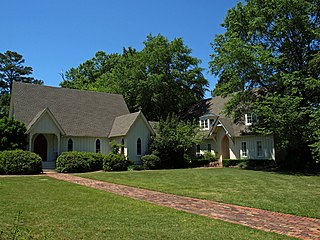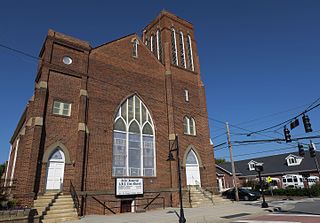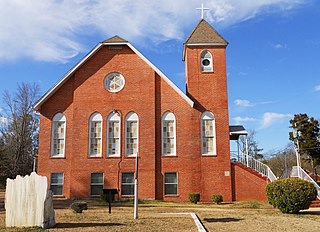
The Mother Bethel African Methodist Episcopal Church is a historic church and congregation at 419 South 6th Street in Center City Philadelphia, Pennsylvania, USA. The congregation, founded in 1794, is the oldest African Methodist Episcopal congregation in the nation. Its present church, completed in 1890, is the oldest church property in the United States to be continuously owned by African Americans. It was designated a National Historic Landmark in 1972.

The Mount Zion AME Church is a historic church in Jacksonville, Florida, United States. It is located at 201 East Beaver Street. On December 30, 1992, it was added to the U.S. National Register of Historic Places. The "AME" is an abbreviation of African Methodist Episcopal, the religious denomination.

The Bialystoker Synagogue at 7–11 Bialystoker Place, formerly Willett Street, between Grand and Broome Streets in the Lower East Side neighborhood of Manhattan, New York City is an Orthodox Jewish synagogue. The building was constructed in 1826 as the Willett Street Methodist Episcopal Church; the synagogue purchased the building in 1905.

The Mount Zion African Methodist Episcopal Zion Church, also known as the Mount Zion AME Zion Church Memorial Annex, is a historic church in Montgomery, Alabama, United States. Located on 467 Holt Street, it was built in 1899 and extensively remodeled in 1921.

The John Street United Methodist Church – also known as Old John Street Methodist Episcopal Church – located at 44 John Street between Nassau and William Streets in the Financial District of Manhattan, New York City was built in 1841 in the Georgian style, with the design attributed to William Hurry and/or Philip Embury. The congregation is the oldest Methodist congregation in North America, founded on October 12, 1766 as the Wesleyan Society in America.

Brown Chapel A.M.E. Church is a church at 410 Martin Luther King Jr. Boulevard in Selma, Alabama, United States. This church was a starting point for the Selma to Montgomery marches in 1965 and, as the meeting place and offices of the Southern Christian Leadership Conference (SCLC) during the Selma Movement, played a major role in the events that led to the adoption of the Voting Rights Act of 1965. The nation's reaction to Selma's "Bloody Sunday" march is widely credited with making the passage of the Voting Rights Act politically viable in the United States Congress.

State Street African Methodist Episcopal Zion Church is a historic African American church in Mobile, Alabama. It is the oldest documented Methodist church building in Alabama. It is also one of two African American churches founded in the Methodist tradition in Mobile prior to the American Civil War.

The Metropolitan African Methodist Episcopal Zion Church is a historic Methodist Episcopal Church at 2051 Main Street in Hartford, Connecticut. This High Victorian Gothic structure was built in 1873-74 for an Episcopal congregation, and has since 1926 been the home to the city's oldest African-American congregation, which was established in 1833. The church was listed on the National Register of Historic Places in 1994.

The Tankersley Rosenwald School, also known as the Tankersley Elementary School, is a historic American Craftsman-style school building in Hope Hull, Alabama, a suburb of Montgomery. This Rosenwald School building was built in 1922 to serve the local African American community. The money to build the school was provided, in part, by the Julius Rosenwald Fund. It was added to the Alabama Register of Landmarks and Heritage on June 26, 2003, and to the National Register of Historic Places as a part of The Rosenwald School Building Fund and Associated Buildings Multiple Property Submission on January 22, 2009.

Grace Episcopal Church is a historic Episcopal church in Mount Meigs, Alabama. The Carpenter Gothic structure was built in 1892. The building was placed on the Alabama Register of Landmarks and Heritage on January 29, 1980, and the National Register of Historic Places on February 19, 1982.

Wesley A.M.E. Zion Church is a historic church at 1500 Lombard Street in Philadelphia, Pennsylvania.

Lomax African Methodist Episcopal Zion Church is an historic African Methodist Episcopal Zion church located at 2704 24th Rd. South in Arlington, Virginia. It was built in 1922, and is a one-story, three bay by six bay, brick church building on a parged concrete foundation. It features two unequal-sized crenellated towers and brick buttresses along the facade and side elevations in the Late Gothic Revival style. Also on the property are two contributing resources, including a cemetery dating from circa 1894, and a parsonage built in 1951. The cemetery contains approximately 107 interments.

St. Peter's AME Zion Church is a historic African Methodist Episcopal church located at 615 Queen Street in New Bern, Craven County, North Carolina. It was built between 1923 and 1942, on the site of the 1914 church building which was destroyed by fire in 1922. It is a large three bay by seven bay, rectangular brick church building in the Late Gothic Revival style. It features a gabled nave flanked by two-story truncated stair towers. Also on the property is the contributing 1926 parsonage; a 2+1⁄2-story, frame American Craftsman style dwelling. It is known within the denomination as the "Mother Church of Zion Methodism in the South," and the oldest existing African Methodist Episcopal congregation in the South.

Goler Memorial African Methodist Episcopal Zion Church, also known as Old Goler, is a historic African Methodist Episcopal Zion church located at 630 Patterson Avenue in Winston-Salem, Forsyth County, North Carolina. It was built in 1918–1919, and is a rectangular brick building in the Late Gothic Revival style. It features a gable-front block flanked by two square brick towers and stained glass windows. A two-story annex was built in 1946. In 1942, the Goler Metropolitan AME Zion Church congregation split from the Goler Memorial African Methodist Episcopal Zion Church.

Goler Metropolitan AME Zion Church, originally known as East Fourth Street Baptist Church, is a historic African Methodist Episcopal Zion church located at 1435 E. Fourth Street in Winston-Salem, Forsyth County, North Carolina. It was built in 1924, and is a front-gabled brick church with two prominent domed towers and flanking one-story hipped-roof wings in the Classical Revival style. The front facade features a prominent pedimented porch supported by stuccoed Doric order columns and Ionic order pilasters. The interior is based on the Akron Plan. The building was acquired by an African-American congregation split from the Goler Memorial African Methodist Episcopal Zion Church in 1942. The congregation changed their name to Goler Metropolitan A.M.E. Zion Church in 1953.

Mount Zion Cemetery/Female Union Band Society Cemetery is a historic cemetery located at 27th Street NW and Mill Road NW in the Georgetown neighborhood of Washington, D.C., in the United States. The cemetery is actually two adjoining burial grounds: the Mount Zion Cemetery and Female Union Band Society Cemetery. Together these cemeteries occupy approximately three and a half acres of land. The property fronts Mill Road NW and overlooks Rock Creek Park to the rear. Mount Zion Cemetery, positioned to the East, is approximately 67,300 square feet in area; the Female Union Band Cemetery, situated to the West, contains approximately 66,500 square feet. Mount Zion Cemetery, founded in 1808 as The Old Methodist Burial Ground, was leased property later sold to Mount Zion United Methodist Church. Although the cemetery buried both White and Black persons since its inception, it served an almost exclusively African American population after 1849. In 1842, the Female Union Band Society purchased the western lot to establish a secular burying ground for African Americans. Both cemeteries were abandoned by 1950.

The Mother African Methodist Episcopal Zion Church, also known as "Mother Zion", located at 140–148 West 137th Street between Adam Clayton Powell Jr. Boulevard and Lenox Avenue in the Harlem neighborhood of Manhattan, New York City, is the oldest African-American church in New York City, and the "mother church" of the African Methodist Episcopal Zion conference.

Butler Chapel African Methodist Episcopal Zion Church is a historic church at 1002 N. Church Street in Tuskegee, Alabama. Built in 1957, it was added to the Alabama Register of Landmarks and Heritage in 1985 and the National Register of Historic Places in 1995. It was an important location associated with the civil rights movement of the 1950s and '60s.

The Mary E. Bell House is a historic house at 66 Railroad Avenue approximately 1/10th mile south of the Long Island rail road in Center Moriches, Long Island, New York. Built in 1872 by Selah Smith of Huntington who purchased the land, it is significant in the area of ethnic history for the Smith and Bell families and the African-American AME Zion community of Center Moriches during the nineteenth and twentieth centuries. It was listed on the National Register of Historic Places in 2020. It is under the Stewardship of the Ketcham Inn Foundation.






















